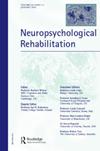Changes in younger stroke survivors' body perception as indicated in body drawings: A comparison between Expressive Arts-based Intervention and control groups.
IF 1.7
3区 心理学
Q4 NEUROSCIENCES
引用次数: 0
Abstract
Stroke-related deficits affect stroke survivors' perception of their bodies and possibly impede their progress in rehabilitation and well-being. This study adopted a pre-and post-test design to compare the changes in body perception among younger stroke survivors after participating in an 8-week Expressive Arts-based Intervention (EABI) (n = 32) with the control group (n = 30). Each participant partook in structured drawing interviews at baseline (T0) and 8-week follow-up/post-intervention (T1). The data were analyzed using content analysis. More EABI (n = 27) than control (n = 14) participants reported positive changes in body perception and applied lighter colours or created a more symmetrical drawing at T1. They shared that EABI promoted these positive changes by facilitating the reconnection with one's body and self. While some control participants experienced positive changes in body perception, others tended to apply darker colours or the same colour to show negative or no changes in body perception. More control (n = 8) than EABI (n = 3) participants reported negative thoughts about their bodies and negative influences from other individuals and the environment. The findings suggested that EABI can change stroke survivors' body perception. EABI can be considered one of the interventions that may help foster positive changes in body perception.身体绘画中显示的年轻中风幸存者对身体感知的变化:以表达艺术为基础的干预组与对照组之间的比较。
与脑卒中有关的缺陷会影响脑卒中幸存者对自己身体的感知,并可能阻碍他们的康复和福祉。本研究采用前测和后测设计,比较年轻中风幸存者在参加为期 8 周的表达艺术干预(EABI)(32 人)和对照组(30 人)后对身体感知的变化。每位参与者都在基线(T0)和 8 周随访/干预后(T1)参加了结构化绘画访谈。数据采用内容分析法进行分析。与对照组(14 人)相比,更多的 EABI 参与者(27 人)报告了身体感知方面的积极变化,并在 T1 阶段使用了更浅的颜色或创作了更对称的绘画。他们分享说,EABI 通过促进与身体和自我的重新连接,促进了这些积极变化。虽然一些对照组参与者在身体感知方面经历了积极的变化,但其他参与者倾向于使用较深的颜色或相同的颜色,以显示身体感知方面的消极变化或无变化。对照组(8 人)比 EABI(3 人)更多的参与者报告了对自己身体的负面想法以及来自其他人和环境的负面影响。研究结果表明,EABI 可以改变中风幸存者对身体的认知。EABI 可被视为有助于促进身体感知发生积极变化的干预措施之一。
本文章由计算机程序翻译,如有差异,请以英文原文为准。
求助全文
约1分钟内获得全文
求助全文
来源期刊
CiteScore
6.30
自引率
7.40%
发文量
78
审稿时长
>12 weeks
期刊介绍:
Neuropsychological Rehabilitation publishes human experimental and clinical research related to rehabilitation, recovery of function, and brain plasticity. The journal is aimed at clinicians who wish to inform their practice in the light of the latest scientific research; at researchers in neurorehabilitation; and finally at researchers in cognitive neuroscience and related fields interested in the mechanisms of recovery and rehabilitation. Papers on neuropsychological assessment will be considered, and special topic reviews (2500-5000 words) addressing specific key questions in rehabilitation, recovery and brain plasticity will also be welcomed. The latter will enter a fast-track refereeing process.

 求助内容:
求助内容: 应助结果提醒方式:
应助结果提醒方式:


